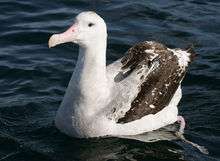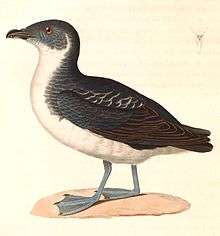List of birds of Antarctica

This is a list of the bird species recorded in Antarctica. The avifauna of Antarctica include a total of 45 species, of which 1 is endemic. This list's taxonomic treatment (designation and sequence of orders, families and species) and nomenclature (common and scientific names) follow the conventions of The Clements Checklist of Birds of the World, 5th edition. The family accounts at the beginning of each heading reflect this taxonomy, as do the species counts found in each family account.
Penguins

Order: Sphenisciformes Family: Spheniscidae
The penguins are a group of aquatic, flightless birds living almost exclusively in the Southern Hemisphere. Most penguins feed on krill, fish, squid and other forms of sealife caught while swimming underwater.
- King penguin, Aptenodytes patagonicus
- Emperor penguin, Aptenodytes forsteri
- Gentoo penguin, Pygoscelis papua
- Adelie penguin, Pygoscelis adeliae
- Chinstrap penguin, Pygoscelis antarctica
- Southern rockhopper penguin, Eudyptes chrysocome
- Macaroni penguin, Eudyptes chrysolophus
Albatrosses

Order: Procellariiformes Family: Diomedeidae
The albatrosses are among the largest of flying birds, and the great albatrosses from the genus Diomedea have the largest wingspans of any extant birds.
- Wandering albatross, Diomedea exulans
- Antipodean albatross, Diomedea antipodensis
- Southern royal albatross, Diomedea epomophora
- Northern royal albatross, Diomedea sanfordi
- Shy albatross, Thalassarche cauta
- Salvin's albatross, Thalassarche salvini
- Grey-headed albatross, Thalassarche chrysostomsa
- Black-browed albatross, Thalassarche melanophris
- Sooty albatross, Phoebetria fusca
- Light-mantled albatross, Phoebetria palpebrata
Shearwaters and petrels
Order: Procellariiformes Family: Procellariidae
The procellariids are the main group of medium-sized "true petrels", characterised by united nostrils with medium septum and a long outer functional primary.
- Antarctic giant petrel, Macronectes giganteus
- Hall's giant petrel, Macronectes halli
- Southern fulmar, Fulmarus glacialoides
- Antarctic petrel, Thalassoica antarctica
- Cape petrel, Daption capense
- Snow petrel, Pagodroma nivea

- Great-winged petrel, Pterodroma macroptera
- White-headed petrel, Pterodroma lessonii
- Blue petrel, Halobaena caerulea
- Broad-billed prion, Pachyptila vittata
- Salvin's prion, Pachyptila salvini
- Antarctic prion, Pachyptila desolata
- Slender-billed prion, Pachyptila belcheri
- Fairy prion, Pachyptila turtur
- Grey petrel, Procellaria cinerea
- White-chinned petrel, Procellaria aequinoctialis
- Kerguelen petrel, Aphrodroma brevirostris
- Sooty shearwater, Ardenna griseus
Storm petrels

Order: Procellariiformes Family: Hydrobatidae
The storm petrels are relatives of the petrels and are the smallest seabirds. They feed on planktonic crustaceans and small fish picked from the surface, typically while hovering. The flight is fluttering and sometimes bat-like.
- Grey-backed storm petrel, Garrodia nereis
- Wilson's storm petrel, Oceanites oceanicus
- Black-bellied storm petrel, Fregetta tropica
Diving petrels
Order: Procellariiformes Family: Pelecanoididae

The diving petrels are small auk-like birds found in the southern oceans. They feed on krill, copepods, small fish and squid.
- South Georgia diving petrel, Pelecanoides georgicus
- Common diving petrel, Pelecanoides urinatrix
Cormorants
1.jpg)
Order: Suliformes Family: Phalacrocoracidae
Phalacrocoracidae is a family of medium to large coastal, fish-eating seabirds that includes cormorants and shags. Plumage colouration varies, with the majority having mainly dark plumage, some species being black-and-white and a few being colourful.
- Antarctic shag, Phalacrocorax bransfieldensis
- Imperial shag, Phalacrocorax atriceps (A)
Ducks, geese and swans
Order: Anseriformes Family: Anatidae

Anatidae includes the ducks and most duck-like waterfowl, such as geese and swans. These birds are adapted to an aquatic existence with webbed feet, flattened bills, and feathers that are excellent at shedding water due to an oily coating.
- Yellow-billed pintail, Anas georgica
Sheathbills
Order: Charadriiformes Family: Chionididae

The sheathbills are scavengers of the Antarctic regions. They have white plumage and look plump and dove-like but are believed to be similar to the ancestors of the modern gulls and terns.
- Snowy sheathbill, Chionis alba
Skuas and jaegers
Order: Charadriiformes Family: Stercorariidae

The family Stercorariidae are, in general, medium to large birds, typically with grey or brown plumage, often with white markings on the wings. They nest on the ground in temperate and arctic regions and are long-distance migrants.
- South polar skua, Stercorarius maccormicki
- Brown skua, Stercorarius antarctica
Gulls
Order: Charadriiformes Family: Laridae
.jpg)
Laridae is a family of medium to large seabirds, the gulls and kittiwakes. They are typically grey or white, often with black markings on the head or wings. They have stout, longish bills and webbed feet.
- Kelp gull, Larus dominicanus
Terns
Order: Charadriiformes Family: Sternidae
.jpg)
Terns are a group of generally medium to large seabirds typically with grey or white plumage, often with black markings on the head. Most terns hunt fish by diving but some pick insects off the surface of fresh water. Terns are generally long-lived birds, with several species known to live in excess of 30 years.
- Arctic tern, Sterna paradisaea
- Antarctic tern, Sterna vittata
See also
References
- Lepage, Denis. "Checklist of birds of Antarctica". Bird Checklists of the World. Avibase. Retrieved 27 April 2007.
- Clements, James F. (2000). Birds of the World: a Checklist. Cornell University Press. p. 880. ISBN 0-934797-16-1.